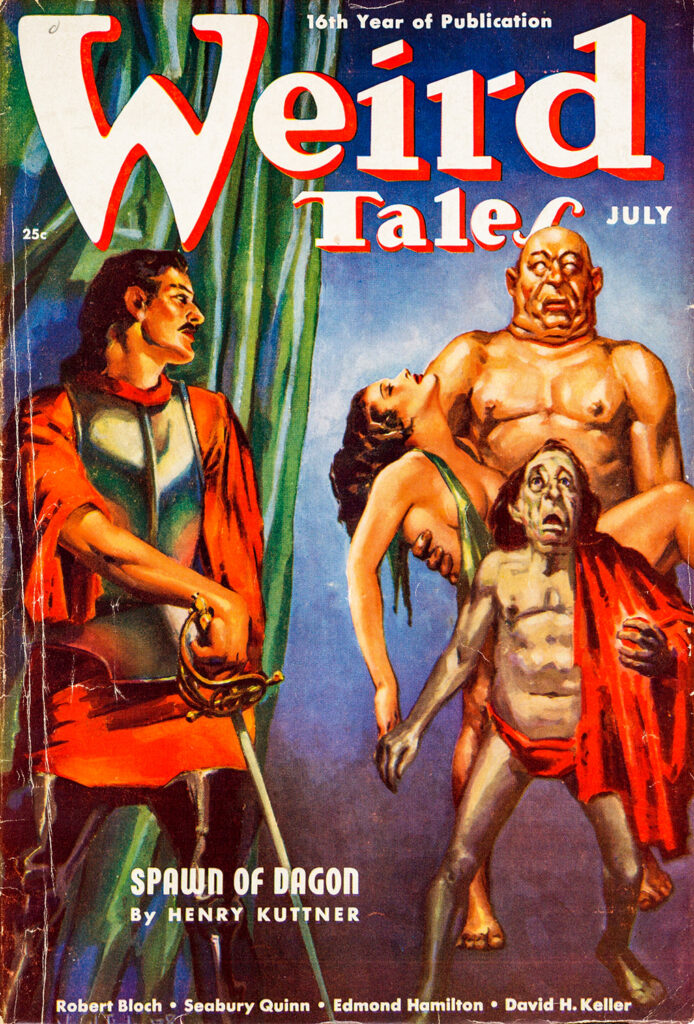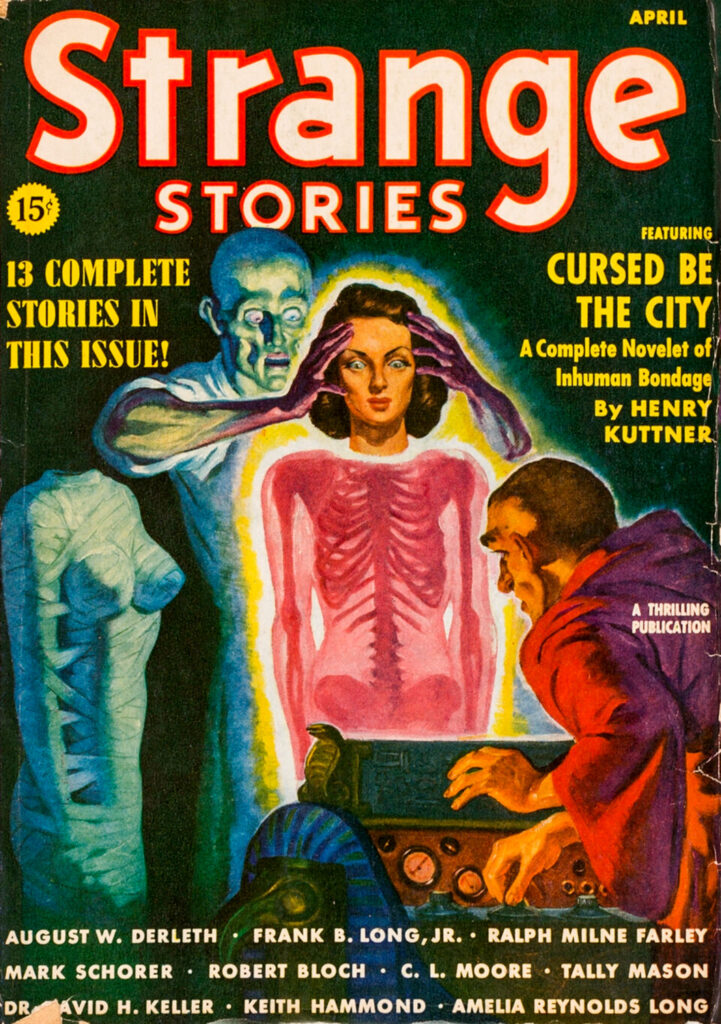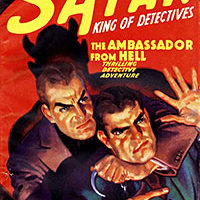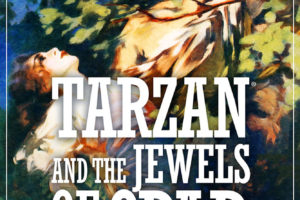A classic pulp sword-and-sorcery hero who has been revived for new stories is Elak of Atlantis. He was created by Henry Kuttner (1915-58), who wrote many pulp stories solo and with his wife, C.L. Moore (1911-87). Kuttner created and wrote Thunder Jim Wade and many short stories, but is not well known for any particular story per se. “The Graveyard Rats” is one notable work, and another is the story that was the basis for The Last Mimsy movie.
 Elak appeared in Weird Tales after Robert E. Howard passed away, so kind of filling the gap left by his death.
Elak appeared in Weird Tales after Robert E. Howard passed away, so kind of filling the gap left by his death.
The character has since been revived by Adrian Cole, who has now written more new stories than there are originals.
In addition to being set in a sword-and-sorcery world, there is a hint of Lovecraftian horror as well in this world. Not surprising as Kuttner was part of the loose “Lovecraft Circle” and wrote several stories in the Mythos.
Elak appeared in four stories in Weird Tales from 1938 to 1941. These stories are “Thunder in the Dawn” (May and June 1938), “Spawn of Dagon” (July 1938), “Beyond the Phoenix” (October 1939), and “Dragon Moon” (January 1941). The last three stories were cover featured, showing the popularity of the character.
These were reprinted, along with the two Prince Raynor stories (from Strange Stories in 1939), in a few collections. I am aware of two volumes out currently that have these and I got the one from Paizo Publishing under their Planet Stories line. This one has all six stories, a map of Atlantis, and a nice intro from Joe Lansdale.
We are introduced to Elak and his associates in the first story. The series is set in Atlantis. This Atlantis is not a super-science civilization, but one of swords and sorcery. The most powerful nation is the kingdom of Cyrene at the northern end of the island continent. The rest are various city-states.
We learn that Elak is really Prince Zeulas of Cyrene. He had killed his step-father, Norian, who was the king, in a fair duel. As he didn’t want to take the throne under such circumstances, he turned it over to his younger brother, Orander, and exiled himself from the kingdom, taking on the name Elak. He was later joined by Lycon, a fat warrior with a love of drink, if you can believe it. In the first story they are joined by Dalan the Druid.
In the first story, the longest, Dalan seeks out Elak as Cyrene is in danger. The warlock Elf has captured Orander and is in league with Vikings who attack the kingdom, as well as the Pikht, an ancient and evil dwarfish race. Elak and Lycon, along with a girl Elak likes, Velia, travel with Dalan along the interior river of Atlantis to Cyrene. It’s not a easy trip, being attacked by allies of Elf, who uses his dark sorcery to try to stop Elak, even sending him to a shadow world. They are able to rally the forces of Cyrene, and in the end, they succeed, and Elak and his friends depart for further adventures (tho we never hear of Velia again).
The next two stories are much shorter, and have only Elak and Lycon in other parts of Atlantis. “Spawn of Dagon” has them in the city of San-Mu dealing with the titular threat. “Beyond the Phoenix” has them in Sarhaddon working for the king, who is betrayed and killed by the high priest who is working for a dark force. They help the princess to put an end to the threat.
The fourth work, “Dragon Moon,” brings the series to a close in some ways. Elak and Lycon must again return to Cyrene to face an even bigger threat. Orander is dead, and they must work with Dalan to stop the threat of Karkora the Pallid One. He is not human, and so Elak must gain the assistance of the daughter of Poseidon. In the end, Elak winds up being king of Cyrene and a more united Atlantis.
 As these are included in this collection, let’s move on to the Prince Raynor stories, which appeared after the third Elak story. “Curse Be the City” and “Citadel of Darkness” both appeared in Thrilling’s Strange Stories, not to be confused with Strange Tales of Mystery and Terror. The first story was cover featured, while the second was noted on the cover. These are set in an unknown prehistoric time. What is the Gobi Desert was then the “Cradle of Mankind,” centered on the city of Sardopolis, of which Raynor is a prince.
As these are included in this collection, let’s move on to the Prince Raynor stories, which appeared after the third Elak story. “Curse Be the City” and “Citadel of Darkness” both appeared in Thrilling’s Strange Stories, not to be confused with Strange Tales of Mystery and Terror. The first story was cover featured, while the second was noted on the cover. These are set in an unknown prehistoric time. What is the Gobi Desert was then the “Cradle of Mankind,” centered on the city of Sardopolis, of which Raynor is a prince.
The first story, “Curse Be the City” (April 1939), introduces us to Raynor and his Nubian servant, Eblik. Sardopolis is doomed as it’s been conquered by another, under the influence of a dark force. Raynor’s father, the king, is slain, and he will soon be tortured to death. But he is freed by Eblik. Raynor must fulfill a prophesized mission that will end the city. And with that done, the two, joined by a girl, Delphia, move on to an unclear fate.
The “Citadel of Darkness” (August 1939) follows, and finds them facing a new evil in the citadel of Ghiar. After which they continue on to whatever awaits them.
Elak of Atlantis was later revived by Adrian Cole in 2007, who at this point has written a further 10 stories. The first appeared in Wild Cat Book‘s Strange Tales #10 in 2007 and the first five are collected in Pulp Hero Press‘s Elak, King of Atlantis (2020), whose cover shows Elak, Lycon, and Dalan. The volume has a nice intro by Robert M. Price, who edited Strange Tales #10, and apparently encouraged Cole to write new Elak stories. I hope we’ll get a collection of the rest of the stories as well.
I read the stories in Elak, King of Atlantis. They follow in chronology from the Kuttner stories, with Elak and Lycon, with help from Dalan, facing new threats to Atlantis, many of a supernatural origin. A new character introduced is Shiveera, the daughter of the pirate king of the Eastern Islands, who appears in several subsequent tales.
If you like sword-and-sorcery characters, these are ones to check out. Both are different and are set in worlds similar to ours, but with differences. I wonder if anyone will try doing new Prince Raynor stories?




[…] (Pulp Superfan): A classic pulp sword-and-sorcery hero who has been revived for new stories is Elak of […]